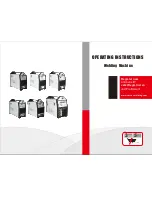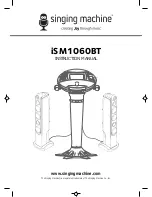
| 11
en
HOT START function
this function is used to make it easier to ignite to welding arc. this function au-
tomatically increases the welding current during the arc ignition. the user can
set the hot start intensity. the function can be completely shut off, which is used
when welding thin materials in order to prevent their burn-through during arc
ignition.
push the set (7) button on the control keyboard. the display (2) will show the
hst sign. choose the desired hot style value (off up to 100 %) with the rotating
selector (11). the status or the value will be shown on the display (14). at the
same time the control light in field 4 will inform you that the value is in percentage
points.
ARC FORCE function
this function helps to stabilize the burning electric arc during welding. it automa-
tically regulates the current and voltage in order to achieve maximum stability of
the arc and reduces the possibility of electrode sticking at the same time.
push the set (7) button on the control keyboard. the display (2) will show the afc
sign. With the rotating selector (11) choose the desired hot style value (off up to
100%). the status or the value will be shown on the display (14). at the same time
the control light in field 4 will inform you that the value is in percentage points.
REMOTE CONTROL function
switching on/off of remote control.
TIG welding method
Basic TIG method welding information
connect the welding torch to the minus clamp and the grounding cable to the
plus clamp.
basic tiG welding method rules:
1. cleanliness - the welding area must be rid of all grease, oil and other dirt. it is
also necessary to pay attention to cleanliness of the material and of the wel-
der’s gloves during welding.
2. filler material induction - in order to prevent oxidation, the end of the filler
material must be under the protection of the gas flowing from the tube.
3. type and diameter of wolfram electrodes - it is necessary to choose these
according to their polarity, current, basic material sort and protection gas com-
position.
4. Grinding of wolfram electrodes - grinding of the electrode’s tip should be done
in a lengthwise direction. the smoother the tip’s surface is, the steadier the
electric arc and the higher the life of the electrode.
5. protective gas - the size of the gas nozzle and the gas flow is set according to
welding current, type of weld and size of the electrode. a feasible flow is about
8 - 10 liters per minute. if the flow is not adequate, the weld could be porous.
after termination of welding the gas must flow sufficiently long (because of
protection of material and the wolfram electrode from oxidation).
table 4 lists common welding current values and wolfram electrodes with 2 %
thorium diameter – red marking.
table 4
Diameter of electrode (mm)
Welding current (A)
1.0
15 - 75
1.6
60 - 150
2.4
130 - 240
prepare the wolfram electrode by following values in table 5 and the picture
below:
α
table 5
α (°)
Welding current (A)
30
0 - 30
60 - 90
30 - 120
90 - 120
120 - 250
Sharpening of tungsten electrode
by the right choice of tungsten electrode and its preparation we can influence
qualities of welding arc, geometry of the weld and durability/service life of the
electrode. it is necessary to sharpen the electrode softly in the traverse/horizontal
direction according to picture.
for welding by method tiG it is necessary to use argon with the purity 99,99 %.
the amount of the flow shall be determined according to the table 6.
table 6
Welding
current
(A)
Ø of electrode
(mm)
Welding nozzle
Gas
flow
(l/min)
n (°)
Ø
(mm)
6 - 70
1,0
4/5
6/8.0
5 - 6
60 - 140
1,6
4/5/6
6.5/8.0/9.5
6 - 7
120 - 240
2,4
6/7
9.5/11.0
7 - 8
Holding of the welding torch during welding:
90°
45°
position w (pa)
position h (pb)































